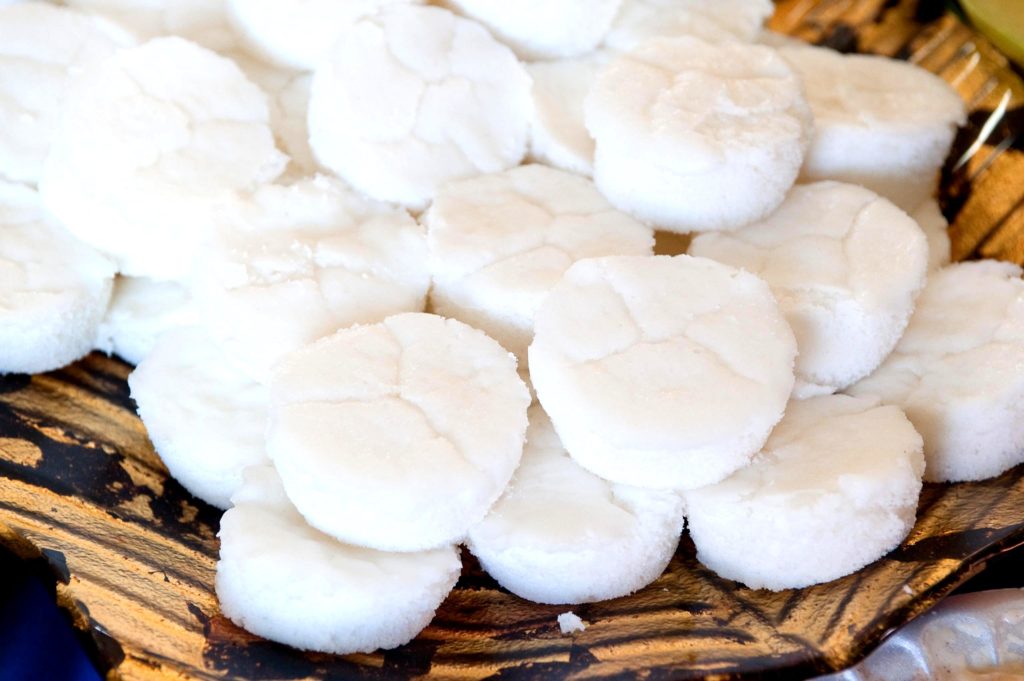Potu: Tuba Rice Cakes

Description
Potu (also spelled poto) are white rice cakes, distinctly flavored with a local coconut toddy or fermented sap called tuba (known as aguardiente in Spanish).
History
Origin
Potu are tuba-flavored rice cakes that were most likely introduced to Guam by Filipino immigrants during the Spanish era, along with other food items such as pancit, lumpia and dinaguan (fritada in CHamoru). In the Philippines this steamed white rice cake is known as puto. There are different varieties and recipes for puto in the Philippines, but for CHamorus, the main ingredients in potu are rice and tuba. Tuba is a fermented drink made from coconut sap.
Evolution
Rice was cultivated by the ancient CHamorus, and was the preferred grain up through Spanish times, in addition to corn. On Guam, rice was grown primarily in low-lying areas, while in the northern islands, at least through the German era, rice was cultivated along terraced slopes on the volcanic ridges in Rota and in marshes around Lake Susupe in Saipan. This technique of wet cultivation was introduced by Filipino immigrants during the Spanish era. Both men and women participated in the cultivation of rice as a communal activity. During the US Naval Era, however, because rice cultivation was laborious, along with limited space for wet cultivation, rice was grown less and less, and imported rice became more popular.
According to Guam historian Robert Rogers, tuba was introduced to Guam as early as 1668 with the arrival of the Jesuit missionary, Father Diego Luis de San Vitores, by his Filipino helpers. Laura Thompson described in her ethnography of the CHamoru people how tuba was produced. Basically, the sap of the coconut plant is collected and fermented to produce a slightly intoxicating substance. The substance could be distilled further to produce a type of rum, called aguardiente.
Preparation
Most fiestas will feature potu that has been purchased from the local grocery or mom-and-pop stores, as preparing potu with the proper texture and flavor is tricky. Indeed a handful of families are reputed to make good potu, such as the Pablo family in Mongmong and a family in Saipan whose traditional clan name is Familian Potu.
Placement on table
Although potu is often eaten as a breakfast item, like a pastry, or a snack, these simple-looking rice cakes are still special enough to have a place at a large fiesta, alongside other desserts at the end of the table or on a separate table.
Recipe
Potu:Tuba Rice Cakes
- 5 pounds long grain rice
- 1 pint sweet tuba
- 1 pint water
- 5 pounds sugar
Add water to cover the level of rice. Let rice soak for two hours, then rinse. Grind rice to a powder. Mix the remaining ingredients and allow to soak overnight. Stir three times during the night. Pour into poto cups** and steam for ten minutes. May be baked at 350 degrees for 10 minutes or until golden brown. Serve with butter.
* Recipe by Bell H. Gumataotao from Lepblon Fina’tinas Para Guam: Guam Cookbook, 1985.
**(Poto cups are individual stainless steel cups. A cupcake tray may be used to substitute individual cups.)